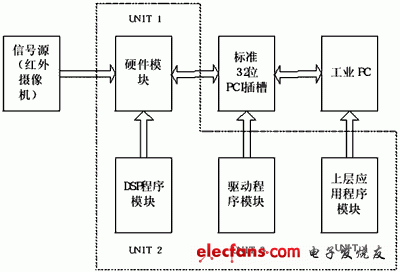Compared with general-purpose integrated circuits, ASIC chips have the advantages of small size, light weight, low power consumption, high reliability, etc., and can reduce costs in high-volume applications. Field Programmable Gate Array (FPGA) was developed on the basis of a dedicated ASIC that overcomes the shortcomings of a dedicated ASIC that is not flexible enough. Compared with other small and medium-sized integrated circuits, the main advantage is that it has great flexibility, that is, its internal specific logic functions can be configured according to needs, and it is convenient to modify and maintain the circuit. The biggest feature of DSP+FPGA structure is flexible structure, strong versatility, suitable for modular design, which can improve the efficiency of the algorithm; at the same time, its development cycle is short, the system is easy to maintain and expand, suitable for real-time digital signal processing. This paper introduces the design of an infrared moving target recognition and tracking system that can be applied to military reconnaissance. Design tasks and requirements The input signal of the infrared moving target tracking and recognition system is an analog or digital video signal provided by the infrared camera. The system processes the infrared digital video sequence in real time through the digital video processing card based on the C6X series high-speed DSP, and completes the search, capture, tracking and memory of the moving target; and displays the infrared video image in real time on the PC to give the moving target in real time. The spatial coordinates generate feature data of the moving target area, and complete real-time storage or remote transmission of the moving target area image. The hardware module needs to provide hardware support for the implementation of the system function, that is, provide the underlying physical support that is compatible with the system function, including the processing speed and storage capacity. Analog video digitization accuracy requirements: AD precision is 8bit; digital video channel requirements: receive data according to RS422 transmission protocol, pixel precision 14bit; image processing time per field <40ms; search capture time: 0.2~1s; capture tracking time < 120ms; 25 frames/s real-time recognition and tracking of moving targets (that is, the current field data must be processed before the next data arrives, and the computer outputs the processing result, displaying the video image), and gives the target position and domain image; The interface is a PCI interface. Overall system design According to the design task and system requirements, the system can be roughly divided into four modules (see Figure 1). Figure 1 system module composition The UNIT 1 module is based on the standard 32-bit +5V PCI bus and is equipped with a very large-scale programmable chip (DSP, FPGA), which has strong computing and processing capabilities. The main function of the UNIT 2 module is to detect and track moving targets in the motion background. Considering the real-time requirements of the system, the moving target detection in the motion background uses a differential technique based on camera motion compensation. Firstly, the global motion caused by camera motion is compensated, and the compensated sequence image is subjected to differential operation; then the motion disturbance region caused by the target motion is searched in the difference domain; finally, the motion target is segmented and extracted on the original video image. At the same time, predictive techniques are used to estimate the possible locations and areas of the target to achieve real-time, accurate tracking (or memory) of the target. The system software is divided into four status modules according to its working status: search, capture, tracking, and memory tracking. The system follows the four states of search, capture, tracking and memory tracking and its conversion operation to realize real-time detection and tracking of moving targets. The main function of the UNIT 3 module is to implement data communication and information interaction between the hardware module and the upper application. The system adopts PCI 9054 Target mode single-cycle read/write; in order to meet the real-time transmission and processing requirements of 25 frames per second during image data transmission, the data transmission of Scatter/Gather DMA of PCI 9054 is adopted. In the information exchange of the whole system, a one-hand handshake protocol is adopted, that is, a one-to-one response protocol is requested. The main function of the UNIT 4 module is to download the DSP tracking program to the hardware module, start/stop the DSP, display the scene video in real time, store the moving target sequence in real time, and perform real-time analysis and display of the basic characteristics of the moving target sequence. Soundproof Tongchai Diesel Generator Tongchai Generator,Soundproof Tongchai Diesel Generator,Tongchai Diesel Generator 500Kva,500Kva Tongchai Generator Jiangsu Lingyu Generator CO.,LTD , https://www.lygenset.com